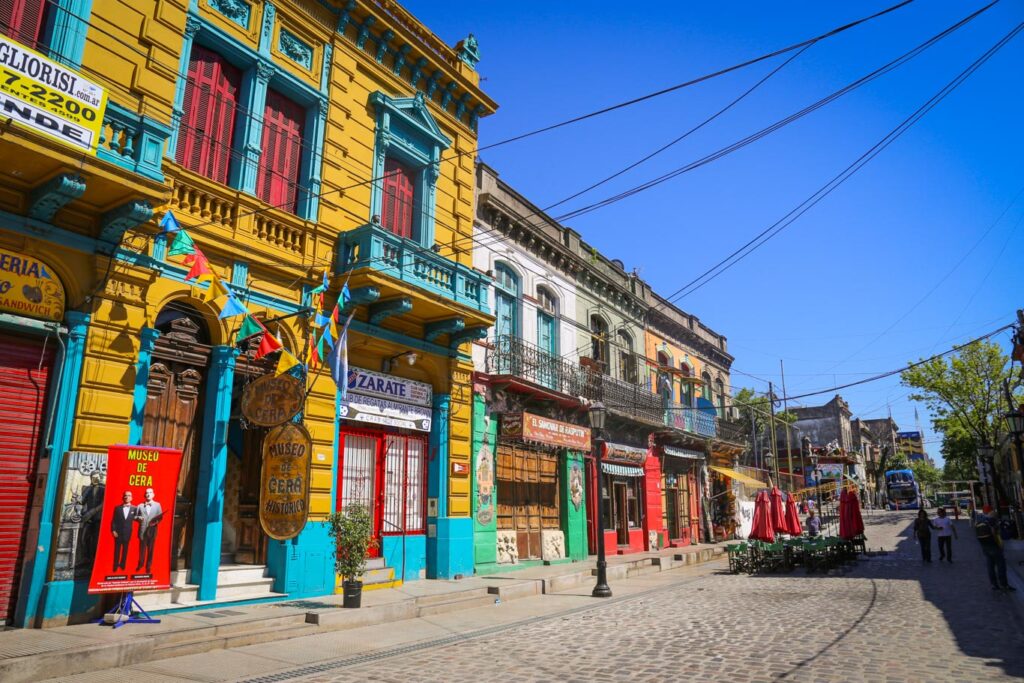Buenos Aires Travel Guide
Home » South America » Argentina » Buenos Aires » Buenos Aires Travel Guide
Buenos Aires, Argentina’s captivating capital, throbs with a unique rhythm. Grand European boulevards lined with cafes hum with lively conversation, while passionate tango dancers swirl through colorful milongas. Explore iconic sights like the pink Casa Rosada presidential palace and the towering Obelisco monument. Beyond landmarks, Buenos Aires’ soul lies in its neighborhoods: La Boca’s vibrant murals, Palermo’s trendy bars, and Recoleta’s serene cemetery offer diverse experiences. From savoring succulent steaks to immersing yourself in the electrifying nightlife, Buenos Aires promises an unforgettable Argentine adventure.

Attractions
Popular Attractions

Teatro Colón

La Boca

Recoleta Cemetery

Plaza de Mayo

Jardín Japonés

Museo Nacional de Bellas Artes

Bosques de Palermo

Caminito

Estadio Monumental
Weather
Buenos Aires Weather by Month
Here’s a table showing the average monthly temperature (°C) and rainfall (mm) in Buenos Aires:
| Month | Average Temperature (°C) | Average Rainfall (mm) |
|---|---|---|
| January | 25 | 100 |
| February | 26 | 80 |
| March | 23 | 80 |
| April | 20 | 60 |
| May | 15 | 50 |
| June | 12 | 50 |
| July | 10 | 40 |
| August | 12 | 50 |
| September | 15 | 50 |
| October | 18 | 70 |
| November | 21 | 80 |
| December | 23 | 100 |
Buenos Aires Travel Guide: Best Time to Travel
The “best” month to visit Buenos Aires depends on your priorities and preferences. Here’s a breakdown of different seasons to help you decide:
Spring (September to November):
Pros:
- Pleasant weather: Warm days with cool evenings, ideal for outdoor activities.
- Fewer crowds: Less crowded than summer, offering a more relaxed experience.
- Cultural events: Buenos Aires International Flower Show, Oktoberfest celebrations.
Cons:
- Unpredictable weather: Occasional rain showers can happen.
- Prices start to rise: Prices gradually increase towards peak season.
Summer (December to February):
Pros:
- Warmest weather: Perfect for enjoying parks, beaches, and outdoor cafes.
- Vibrant atmosphere: The city comes alive with energy and excitement.
- Carnival (February): Experience the world-famous festival if your visit coincides.
Cons:
- Highest prices: Hotels, flights, and activities are most expensive during peak season.
- Largest crowds: Expect packed tourist attractions and public transportation.
- More rain: December and January are the wettest months.
Autumn (March to May):
Pros:
- Mild weather: Enjoyable for sightseeing and outdoor activities without summer heat.
- Lower prices: More affordable than summer and spring, especially in April and May.
- Fewer crowds: Smaller crowds compared to peak season.
Cons:
- Unpredictable weather: Similar to spring, occasional rain showers are possible.
- Limited cultural events: Fewer major events compared to other seasons.
Winter (June to August):
Pros:
- Lowest prices: The most affordable time to visit Buenos Aires.
- Smallest crowds: Enjoy the city with minimal tourist congestion.
- Dry season: Less rain overall, although occasional showers can still occur.
Cons:
- Coolest weather: Not ideal for beach activities, and some attractions may have shorter hours.
- Tango season ends: Tango shows and milongas are less frequent after June.
Overall:
- For warm weather and outdoor activities: Spring (September to November) or Summer (December to February) are ideal.
- For budget travelers and smaller crowds: Autumn (March to May) or Winter (June to August) are better options.
- For experiencing Carnival: February is the only choice.
Remember: These are just general guidelines, and the “best” time for you ultimately depends on your personal preferences and travel priorities.
Public Transportation
Public Transportation
Navigating Buenos Aires: A Smooth Tango or Clumsy Chacarera?
Getting around Buenos Aires can be a breeze or a stumble, depending on your approach. Here’s the lowdown:
Pros:
- Extensive network: Subte (metro), buses, taxis, and bikes offer options for most journeys.
- Subte: Clean, reliable, covers major tourist areas, frequent trains during peak hours.
- SUBE card: Reloadable card for metro, buses, and trains, saves money and hassle.
- Bike lanes: Growing network for cycling enthusiasts, especially in Palermo and Recoleta.
Cons:
- Limited Subte reach: Doesn’t cover all neighborhoods, requiring connections for some destinations.
- Bus complexity: Extensive but can be confusing for newcomers, language barrier a hurdle.
- Rush hour crowds: Subte and buses get packed, especially during peak times.
- Taxi scams: Negotiate fares beforehand and be wary of unlicensed taxis.
Travel Passes:
- SUBE card: Essential for metro, buses, and trains, purchase and reload at kiosks or stations.
- BA Tourist Pass: Unlimited rides on metro, buses, and pre-paid bike rentals for a fixed period, good for sightseeing.
Overall:
With planning and awareness, navigating Buenos Aires becomes manageable. Embrace the Subte, consider the SUBE card for convenience, and don’t hesitate to ask locals for help. Remember, like a good tango, navigating this vibrant city requires some practice and grace, but the rewards are well worth it!
Buenos Aires, Argentina’s captivating capital, throbs with a unique rhythm. Grand European boulevards lined with cafes hum with lively conversation, while passionate tango dancers…
